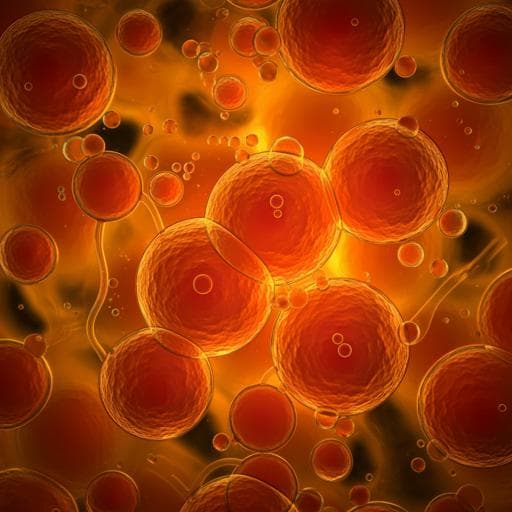
Food Science and Technology
The effect of macromolecular crowding degree on the self-assembly of fatty acid and lipid hydrolysis
Y. Sun, B. Ge, et al.
Explore the fascinating findings of Yu-Long Sun and colleagues as they reveal how macromolecular crowding influences the autocatalytic production of fatty acids, uncovering intriguing differences in vesicle behavior and implications for lipid digestion in crowded environments.
~3 min • Beginner • English
Introduction
The study addresses how macromolecular crowding influences the self-assembly of fatty acids and the kinetics of lipid hydrolysis, processes central to lipid digestion at the lipid–water interface. Prior work indicates that during digestion, complex nanostructures form and evolve, affecting interfacial properties and thus digestion efficiency. Lipid digestion differs from other nutrient hydrolysis because lipase acts at oil–water interfaces and hydrolytic products (fatty acids) are amphiphiles that self-assemble into nanostructures, impacting adsorption and reaction kinetics. A simplified model is needed to probe how nanostructure development and transformation modulate lipid hydrolysis. The authors propose an autocatalytic hydrolysis model of fatty acid anhydrides in crowded media to mimic aspects of intestinal conditions: fatty acids produced during hydrolysis form vesicles that catalyze further hydrolysis, with reactions occurring in confined spaces due to macromolecules. Given that significant gut space is occupied by macromolecules, the study investigates how the degree of macromolecular crowding (tuned by PEG) quantitatively affects fatty-acid self-assembly and lipid-hydrolysis-like reactions for fatty acids with different chain lengths.
Literature Review
The introduction synthesizes several lines of prior research: (1) During intestinal lipid digestion, lamellar liquid-crystal phases and unilamellar vesicles form at emulsion–water interfaces, and milk digestion produces varied ordered nanostructures that influence absorption. (2) Interfacial properties (droplet size, interfacial area, surface tension, viscoelasticity) govern lipase-driven hydrolysis; the amphiphilic products (fatty acids) and other amphiphiles (phospholipids, cholates, emulsifiers) self-assemble, affecting digestion thermodynamics and kinetics. (3) Autocatalytic hydrolysis of fatty acid anhydrides in crowded media can model aspects of lipid digestion (vesicle formation, interfacial catalysis, partitioning/solubilization). (4) Macromolecular crowding, via excluded-volume effects, alters thermodynamic, kinetic, and structural properties of biomacromolecules; prior work by the authors showed polysaccharide-based crowding affects lipase activity and digestion efficiency. However, a quantitative understanding of how crowding degree modulates fatty-acid self-assembly and hydrolysis has been lacking.
Methodology
Model system: autocatalytic hydrolysis of fatty acid anhydrides to fatty acids that self-assemble into vesicles, serving as interfacial catalysts. Two anhydrides were used to represent different chain lengths: decanoic (C10) anhydride and oleic (C18) anhydride. Macromolecular crowding was modeled using polyethylene glycol (PEG) at different molecular weights (PEG200, PEG2000, PEG20000) and concentrations (e.g., 0.1 wt%, 1.0 wt%, 10 wt%).
Reaction conditions: Hydrolysis of C10 anhydride at 60 °C in Tricine buffer (0.3 mol/L, pH 8.25) and C18 anhydride at 41 °C in Bicine buffer (0.2 mol/L, pH 8.50). PEG was added at desired concentrations to adjust crowding degree. A seeded (planted) vesicle approach was also used: preformed sodium decanoate or sodium oleate vesicles were added before starting hydrolysis to probe catalytic effects.
Quantification of fatty acids: Total (protonated + deprotonated) fatty acid concentration in vesicle suspensions was monitored by FT-IR spectroscopy (CaF2 cell, 0.02 cm pathlength, 1900–1600 cm−1).
Aggregate sizing and morphology: Dynamic light scattering (DLS) using a Zetasizer Nano-ZS (He–Ne 632.8 nm, backscatter 173°) determined size distributions at reaction temperatures (60 °C for C10; 41 °C for C18). Samples filtered (0.22 μm) prior to measurement. Transmission electron microscopy (TEM; JEM-1230, 120 kV; negative staining with 1.0% w/v uranyl acetate) imaged vesicle morphologies.
Rheology: Viscosity and oscillatory rheology were measured on a TA DHR-2 rheometer with a Peltier concentric cylinder system. Samples equilibrated to measurement temperature for ≥20 min. Shear viscosity as a function of shear rate was recorded; medium viscosity (PEG solution) was subtracted to obtain Δη attributable to vesicles. Oscillatory frequency sweeps yielded elastic (G′) and viscous (G″) moduli, critical frequency f* (G′=G″), critical modulus G*, and relaxation time τR=1/f*. Cole–Cole plots assessed viscoelastic behavior and Maxwell model applicability.
Data analysis: Time-course of fatty acid formation assessed autocatalytic kinetics in dilute vs crowded media; effects of PEG MW and concentration on induction time, completion time, and rate were compared between C10 and C18 systems.
Key Findings
- Crowding degree effect on rates: Increasing PEG concentration/MW (higher crowding) slowed the autocatalytic production of C10 fatty acid (longer induction and completion times) but accelerated production of C18 fatty acid relative to dilute buffer.
- Size and morphology (DLS/TEM): For C10, increasing crowding yielded larger aggregates/vesicles (DLS single narrow peak; TEM showing ~80 nm vesicles in buffer growing larger with PEG20000, with filament connections indicative of polymer-induced pearling instability). For C18, dilute buffer exhibited very large bi-/multilamellar vesicles (~200–1000 nm), whereas increasing crowding reduced vesicle size and favored unilamellar morphologies. Thus, crowding induced a chain-length-dependent size response: size increased for C10 but decreased for C18.
- Mechanistic linkage: Vesicle catalytic efficiency depends on aggregate size; small vesicles catalyze reactions more efficiently than large ones. Accordingly, the rate decrease for C10 correlated with vesicle size increase; the rate increase for C18 correlated with vesicle size decrease and resulting active, monodisperse vesicle populations.
- Seeded vesicles: Preformed C10 vesicles accelerated C10 anhydride hydrolysis in both buffer and PEG2000. Preformed C18 vesicles accelerated C18 anhydride hydrolysis in buffer but, in PEG2000, decreased the C18 production rate, suggesting different polymer–surfactant interactions for C10 vs C18 under crowding.
- Rheology (shear viscosity): After subtracting medium viscosity, Δη for C10 vesicles was higher in PEG (and increased with higher crowding degree), indicating more viscous behavior; for C18 vesicles, Δη decreased with increasing crowding, indicating reduced interfacial viscosity. The viscosity trends are consistent with size changes (larger C10 vesicles increasing viscosity; smaller C18 vesicles decreasing viscosity) and with stronger hydrophobic interactions for C18 leading to shrunken vesicles and smaller hydrodynamic volumes under crowding.
- Oscillatory rheology: In PEG solutions, both G′ and G″ increased with frequency; G′<G″ at low frequency with a crossover at f*, after which G′>G″, indicating increased elasticity. Compared to PEG alone, addition of vesicles shifted f* to higher values (shorter τR) for C10 with increasing crowding (more viscous behavior), but to lower f* (longer τR) for C18 (more elastic network formation). In 10 wt% PEG20000 with C10 vesicles, G′ dominated G″ with minimal frequency dependence and no crossover, characteristic of gel-like behavior. Cole–Cole plots were not semicircular at low frequency, indicating non-linear viscoelasticity not captured by a single-relaxation-time Maxwell model.
- Overall: Crowding increased interfacial viscosity and reduced diffusion for C10 vesicles, slowing autocatalytic hydrolysis; for C18 vesicles, crowding decreased interfacial viscosity and enhanced diffusion, accelerating hydrolysis.
Discussion
The work demonstrates that macromolecular crowding exerts chain-length-dependent control over fatty-acid self-assembly and, consequently, over autocatalytic hydrolysis rates that model aspects of lipid digestion. By tuning PEG crowding, vesicle size and morphology change in opposite directions for C10 and C18 systems, modulating interfacial catalytic efficiency and mass transport. Larger, more viscous C10 vesicles under crowding provide less effective catalytic surface and hinder diffusion, slowing hydrolysis. In contrast, crowding promotes smaller, more elastic, unilamellar C18 vesicles with reduced interfacial viscosity, facilitating diffusion and enhancing autocatalysis. Seeded-vesicle experiments further reveal differing polymer–surfactant interactions across chain lengths, with PEG suppressing the catalytic benefit of preformed C18 vesicles while maintaining or enhancing that of C10. Rheological signatures (G′/G″, f*, τR) corroborate the viscous vs elastic dominance in C10 vs C18 systems under crowding, respectively. These findings address the central question of how crowding degree affects self-assembly and hydrolysis, offering mechanistic insight relevant to intestinal digestion where macromolecular crowding and amphiphile self-assembly co-occur.
Conclusion
The study establishes that macromolecular crowding, modeled by PEG of varying molecular weight and concentration, differentially regulates self-assembly and autocatalytic hydrolysis of fatty acids depending on chain length: increased crowding slows decanoic acid formation by enlarging vesicles and increasing interfacial viscosity, while it accelerates oleic acid formation by shrinking vesicles, lowering interfacial viscosity, and enhancing diffusion. Vesicle morphology transitions (toward unilamellar C18 vesicles) and rheological behavior (viscous C10 vs elastic C18 responses) underpin these effects. This work provides a simplified yet physiochemically relevant framework for understanding lipid digestion processes involving interfacial catalysis and crowding. Future research could extend to enzyme-catalyzed lipid hydrolysis under crowding, broader ranges of fatty acid chain lengths and unsaturation, more physiologically relevant macromolecular crowders, and in situ characterization of interfacial rheology and mass transport during digestion.
Limitations
- Mechanistic details of polymer–surfactant interactions remain unresolved; the authors note the detailed mechanism is not clear, particularly regarding PEG interactions with C10 vs C18 aggregates and potential polymer/surfactant complex formation.
- Rheological modeling with a single-relaxation-time Maxwell model provided poor fits, indicating complex, non-linear viscoelastic behavior not fully captured by the model.
- The study employs a simplified, enzyme-free autocatalytic anhydride hydrolysis model at elevated temperatures (60 °C for C10, 41 °C for C18) and PEG as crowder; while informative, these conditions may not fully replicate intestinal physiology.
- Only two fatty acid chain lengths (C10 and C18) were examined; generalizability across other chain lengths and amphiphile mixtures remains to be validated.
Related Publications
Explore these studies to deepen your understanding of the subject.







